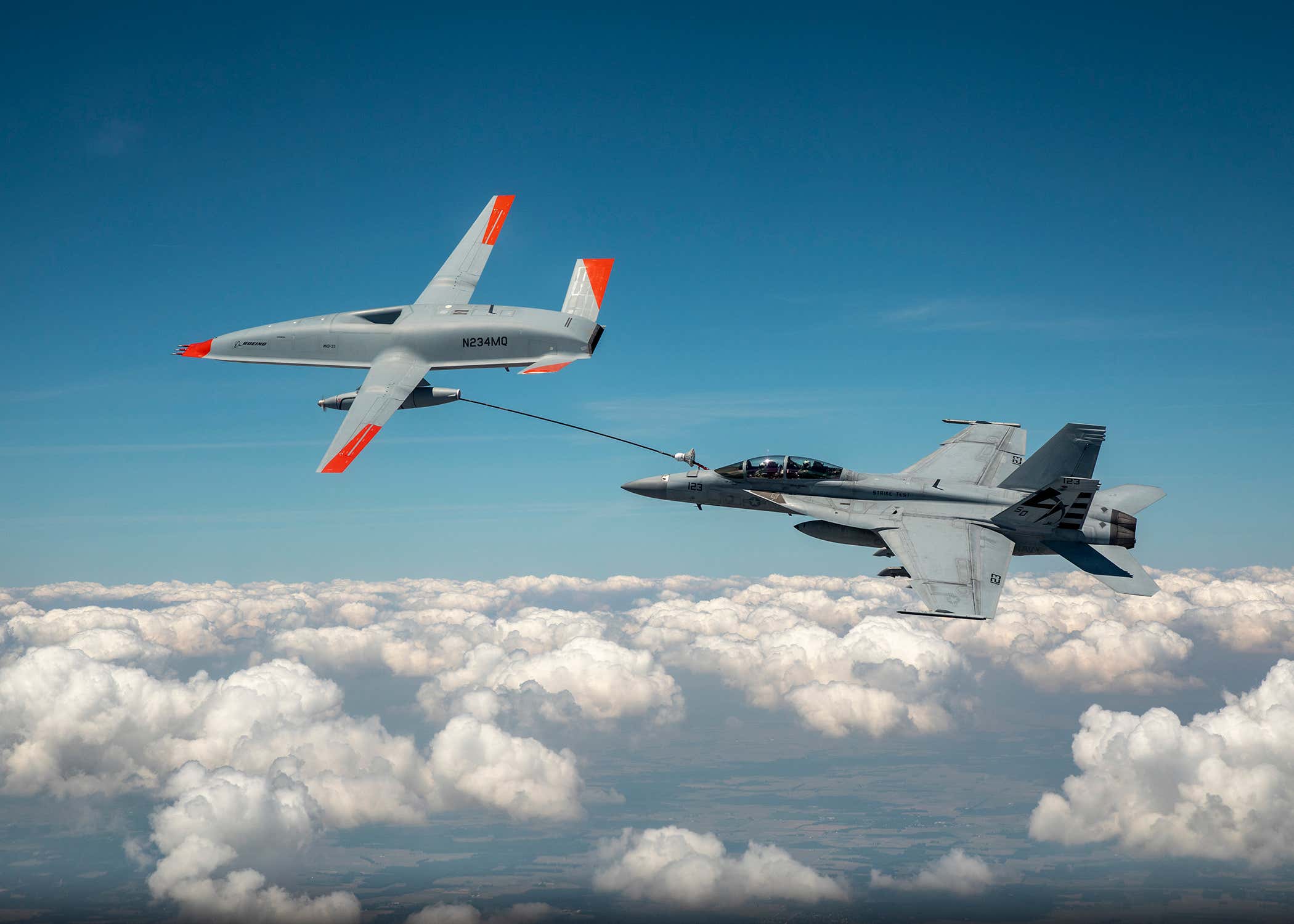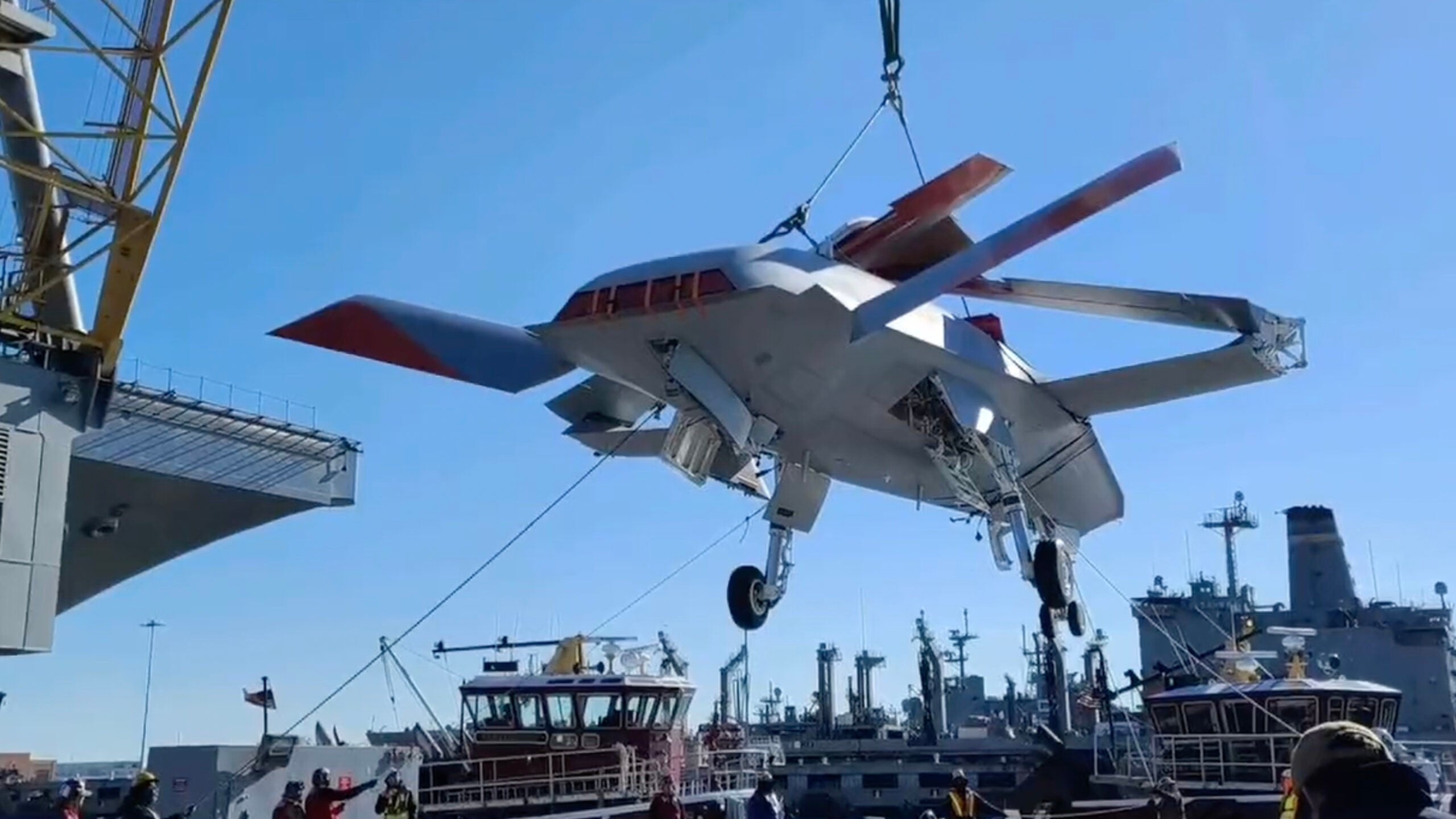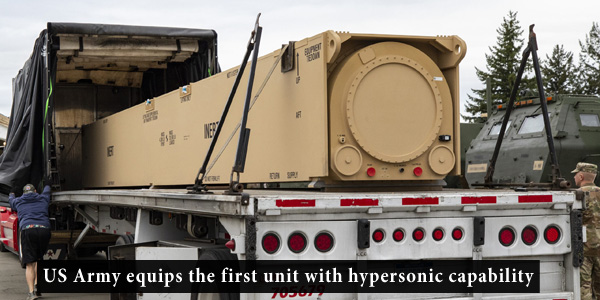U.S. Navy brings Unnamed Refueling Tanker Drone onboard Aircraft Carrier for further testing
IRIA Staff - December 02, 2021 (Updated on December 22, 2021)

The U.S. Navy’s MQ-25 Stingray Tanker Drone is the first of its kind production unit of the U.S. Navy’s Carrier-Based Aerial-Refueling System (CBARS) program. MQ-25 is basically a Flying Filling Station for planes.
The drone is about 15 meters long and has a wingspan of over 22.9 meters. Keeping under consideration its usage at the aircraft carriers, the wings have been designed to fold into a length no more than 9.5 meters. The height of the drone is about 3 meters with extended wings and 4.7 meters with folded wings and rudders. It is powered by Rolls Royce AE 2007N Turbofan Engine. MQ-25 Stingray Tanker Drone can carry up to 7250 kg of fuel in one filling and has the ability to deploy filling pipes from either side of the wings.
The unmanned aerial refueling system got the nod of approval after demonstrating successful mid-air refueling for the F-35C Lightning II and F/A-18F Super Hornet strike fighters and the E-2D Advanced Hawkeye radar plane.
The plans to build a refueling drone surfaced in 2011, however, it was later in the fiscal year 2014 budget submission when CBARS was approved. The U.S. Navy contacted leading aerospace manufacturers including Lockheed Martin, Northrop Grumman, Boeing, and General Atomics for proposal requests.
 The MQ-25 T1 conducts aerial refueling trials with a Navy F/A-18F Super Hornet. (Image Credit: U.S. Navy)
The MQ-25 T1 conducts aerial refueling trials with a Navy F/A-18F Super Hornet. (Image Credit: U.S. Navy)
In 2017, General Atomics proposed their Sea Avenger concept which was enlarged from its Predator-C/Avenger while Lockheed Martin proposed their Sea Ghost concept based on the RQ-170 Sentinel. Northrop Grumman announced that it was withdrawing its X-47B concept that was originally proposed for this project. While Boeing unveiled its prototype aircraft which incorporated designs from its Phantom Ray flying wing and other unmanned aerial systems.
In 2018, the U.S. Navy announced Boeing as the winner for the bid and awarded an $805 million development contract for MQ-25A aircraft to be completed by August 2024.
According to Navy Unmanned Carrier Aviation program manager Captain Chad Reed, “An unmanned aerial refueling capability will extend the range of the carrier air wing and make better use of navy combat strike fighters that currently conduct aerial refueling missions while reducing the human risk factor of such missions... Once operational, the MQ-25A Stingray will be the world’s first carrier-based, unmanned aircraft, providing a robust organic refueling capability to the carrier air wing.”
On December 2, 2021, MQ-25 Stingray Tanker arrived to board the USS George H.W. Bush CVN-777 Aircraft carrier for the first time to be tested in carrier settings. Although the flight testing in an aircraft carrier setting is not going to be conducted just yet, the Navy is planning to explore how the drone can be integrated into the onboard ship, including testing its movements on the elevator deck and storage in the hanger.
 MQ-25 Stingray Tanker Drone. (Image Credit: US Navy)
MQ-25 Stingray Tanker Drone. (Image Credit: US Navy)
The USS George H.W. Bush was selected for these tests for having Navy flattops that have been modified and integrated with Unmanned Carrier Aviation Mission Control System or UMCS, which is necessary for operating the MQ-25 Stingray Tanker Drone. Before boarding the USS George H.W. Bush the Stingray Tanker had to go through some modifications to make it more compatible with an aircraft carrier setting. It was integrated with new systems that enable the personnel to remotely move it around the deck.
For two weeks, the aircraft carrier George H.W. Bush hosted the U.S. Navy’s first MQ-25A Stingray tanker drone conducted an at-sea demonstration with the carrier’s first F-35C Joint Strike Fighter flight operations.
On December 20 the U.S. Navy completed an unmanned carrier aviation demonstration, with the successful installation of a ground control station on the ship and proving the UAV could integrate into that carrier environment. The drone was stationed on a pitching flight deck, with the operator following the hand signals of the aircraft handlers, and with ship-based operators maintaining connectivity while the drone was midair and away from the carrier.
Unmanned carrier aviation program manager, Captain Chad Reed said, “Early testing allowed our team the opportunity to evaluate many new systems for the first time at sea with T1. Our initial look at taxi operations on the flight deck successfully demonstrated the MQ-25′s ability to maneuver just like a manned aircraft in the shipboard environment.”
“There is no better way to determine the success of a carrier aircraft design and its integration into the air wing then to put that new aircraft through testing at sea… It’s an exciting time as we progress toward the air wing of the future.” Reed added.
According to the official news release, a prototype MD-5 ground control station was installed in what is being called an Unmanned Aviation Warfare Center, a first-of-its-kind control room that would be set up on carriers to support MQ-25 operations.
The U.S. Navy is looking forward to fielding its first operational carrier-based unmanned aircraft with initial operating capacity in the year 2025.
ALSO READ:
Regions
Issues

















 United States to develop new Hypersonic Interceptor System
United States to develop new Hypersonic Interceptor System US Army equips the first unit with hypersonic weapon capability
US Army equips the first unit with hypersonic weapon capability







